
All iLive content is medically reviewed or fact checked to ensure as much factual accuracy as possible.
We have strict sourcing guidelines and only link to reputable media sites, academic research institutions and, whenever possible, medically peer reviewed studies. Note that the numbers in parentheses ([1], [2], etc.) are clickable links to these studies.
If you feel that any of our content is inaccurate, out-of-date, or otherwise questionable, please select it and press Ctrl + Enter.
Osteoarthritis pills
Medical expert of the article
Last reviewed: 04.07.2025
Arthrosis is a serious joint disease, manifested by progressive depletion of cartilage tissue, leading to its destruction. Over time, the destructive process affects the ligamentous apparatus and bone tissue. Patients are at risk of complete loss of mobility.
The disease is caused by a disruption of metabolic processes in the joint tissues, it loses flexibility and smoothness. Qualitative and quantitative changes in the synovial fluid occur, the cartilaginous tissue loses its normal structure.
Modern medicine considers the causes that provoke the onset of destruction of articular cartilage to be metabolic diseases, endocrine disorders, impaired blood supply to the joint, heredity, age-related changes, injuries, rheumatic and autoimmune diseases.
Arthrosis is the leading joint disease. It is increasingly common in 30-year-olds, and by the age of 60, changes in the structure of cartilage tissue are found in almost everyone.
Treatment of arthrosis is long-term, comprehensive, aimed at stopping the progression of the disease, reducing joint pain and restoring its mobility, preventing consequences and complications.
Indications osteoarthritis pills
Tablets for arthrosis are prescribed in case of treatment of stages I - III of the disease:
- primary and post-traumatic lesions of the cartilaginous tissue of the joints and spine;
- osteochondrosis of the spine;
- extra-articular rheumatism;
- acute injuries to joints and bones.
They are also prescribed after joint replacement surgery as a means of accelerating the recovery process.
Release form
 [ 4 ]
[ 4 ]
Artra
A combined chondroprotector consisting of equal parts (500 mg each) of sodium chondroitin sulfate and glucosamine hydrochloride, which interact productively with each other. The first component makes joints flexible, helps retain water in cartilage tissue, and deactivates enzymes that destroy cartilage. The second is a building substance for the formation of cartilage tissue. It promotes the formation of chondroblasts, i.e. restoration of cartilage tissue destroyed by disease, restores joint mobility, and has an analgesic effect. Chondroitin accelerates chondrogenesis, i.e. the creation of cartilage tissue, begins to outpace its destruction. Glucosamine stabilizes this process. The active ingredients of the drug stimulate the synthesis of the basis of connective tissue (proteoglycans), which serves as a lubricant in the joints, due to which the perichondrium of the bones in the joint begins to wear out less, and joint pain passes.
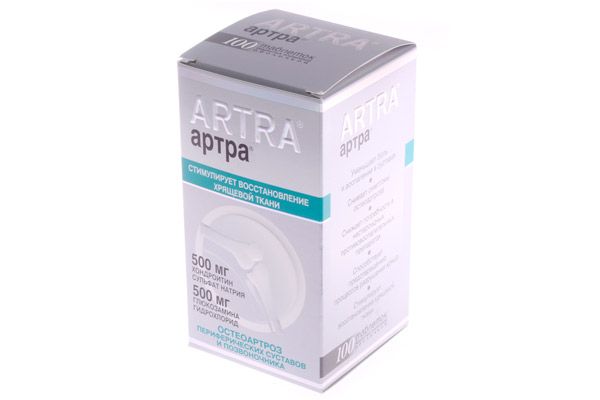
Taking Arthra tablets helps to reduce the dose of NSAIDs and hormonal drugs that are used for inflammation with severe pain.
When taking the product, the biological availability of the active ingredients is 25% glucosamine and 13% chondroitin. The liver, kidneys and articular cartilage accumulate a high concentration of the active elements of the tablets. About a third of the taken glucosamine remains in the tissues of bones and muscles for a long time. It is excreted mainly by the kidneys, and also by the intestines.
This is a dosage form for oral use. To avoid contact with the oral mucosa, the tablets are coated. Take without breaking the integrity, independently of food intake, with a sufficient amount of drinking water.
Intended for adult patients only. Unless otherwise advised, take one tablet morning and evening for three weeks, then reduce the dose to one tablet per day.
The duration of treatment is approximately 4-6 months. If necessary, the course of taking Artra tablets can be repeated after a few months.
The duration of the course and the dosage of the drug corresponding to the severity of the disease are determined by the attending physician.
The use of these tablets rarely causes side effects. There are isolated episodes of epigastric pain, stool disorders, flatulence and dizziness during treatment with this drug. In rare cases, an allergic reaction may be observed.
Usually, severe idiosyncrasies requiring discontinuation of treatment with this drug have not been observed. The occurrence of undesirable effects should be reported to the attending physician.
Caution should be exercised when operating potentially hazardous machines, such as driving a car, during treatment with this drug (glucosamine-induced dizziness).
Contraindications to the use of Artra tablets are established hypersensitivity to their components, renal dysfunction, childhood and adolescence, pregnancy and breastfeeding. Use with caution in patients with bronchial asthma, diabetes mellitus, bleeding or risk of bleeding.
The drug Artra, when interacting with NSAIDs and glucocorticosteroids, fibrinolytics, as well as drugs that prevent the formation of blood clots or inhibit platelet aggregation, enhances their effectiveness.
Interacting with tetracyclines increases their absorption in the intestine.
When taken together, it reduces the effectiveness of penicillin antibiotics.
There are no known cases of overdose with Artra.
The shelf life is 5 years, provided the temperature regime is 10–30 °C.
Teraflex
The closest synonym of the drug is Arthra, has the same active ingredients. The difference between these drugs is in the dosage of chondroitin - one capsule of Teraflex includes 500 mg of glucosamine and 400 mg of chondroitin.
Pharmacology, contraindications, interactions with other drugs and side effects are similar.
There are two types of tablet forms of this drug: Teraflex and Teraflex Advance.
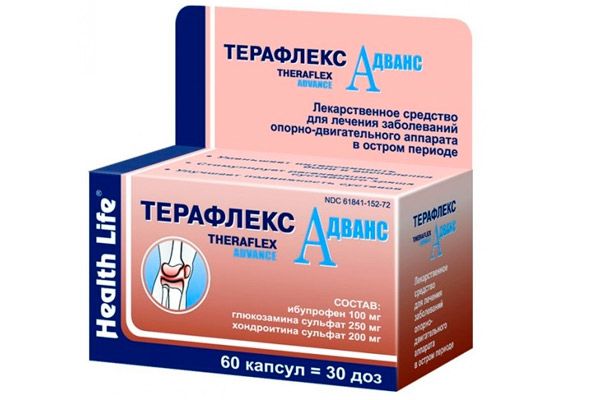
Their main difference is that Teraflex Advance also contains the non-steroidal anti-inflammatory drug ibuprofen. Classic Teraflex is usually used in the treatment of the chronic form of the disease, and Teraflex Advance is used for significant joint pain (exacerbation). Chondroitin and glucosamine increase the effectiveness of ibuprofen, so Teraflex Advance has a more pronounced anti-inflammatory and pain-relieving effect. Since ibuprofen has many contraindications for use, Teraflex Advance may not be prescribed to every patient.
Overdose may cause: vomiting, abdominal pain, dizziness, fainting, insomnia, hypertensive syndrome, liver (renal) failure, liver necrosis.
To eliminate the consequences of taking a dose of the drug that significantly exceeds the prescribed dose, it is necessary to wash out the stomach.
The shelf life is 3 years, provided the temperature regime is 17–25 °C.
Dona
The active ingredient of this drug is glucosamine sulfate.
This product compensates for the lack of glucosamine, a raw material for cartilage tissue repair that activates chondrocyte activity. Glucosamine stimulates the production of the main components of cartilage and subsequently protects it from destruction, causing natural regeneration of joint tissues.
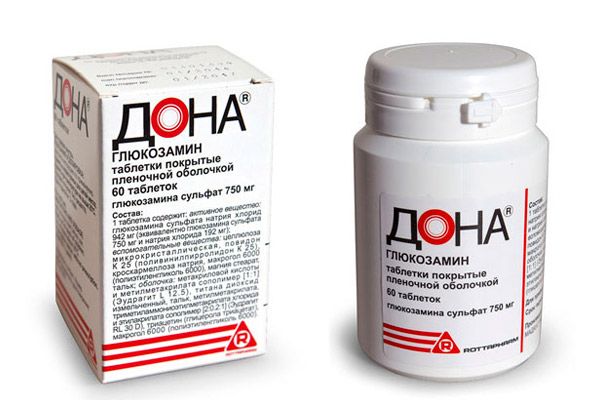
Available in 750 mg tablets and 250 mg capsules for oral administration. Tablets are taken in the morning and evening during meals with a glass of water. Capsules should be taken 4-6 pieces per day.
Improvement of the condition becomes noticeable 2-3 weeks after the start of use. The minimum duration of treatment is 4 weeks. Repeat the course as needed with breaks of two months.
The shelf life is 2 years, provided the temperature regime is up to 25 °C.
Structum
Contains an active substance - chondroitin sulfate, which promotes the regeneration of cartilage tissue, saturating it with water by increasing the ability of proteoglycans to absorb water.
The action of the drug is to delay the excretion of calcium, accelerate the reparation of cartilage tissue and support the natural structure of its matrix.
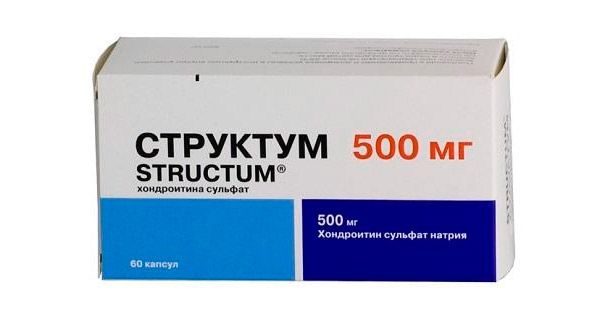
The recommended daily therapeutic dose is 1000 mg, with maintenance therapy the dose is prescribed individually. The drug is taken regardless of food intake. The capsules must be taken whole, with a sufficient amount of water. The duration of the course of treatment with Structum is 3-6 months. After 2-5 months, a repeat course can be prescribed if necessary.
Shelf life is 3 years, provided the temperature regime is up to 25 °C.
In complex therapy for the treatment of arthrosis, you can use Biolika health products, made from environmentally friendly plant materials that do not contain synthetic ingredients.
Arthro-biol
Arthro-biol is a tonic and general health-improving agent. It has an active anti-inflammatory, bactericidal and antipyretic effect. It helps to normalize blood pressure and reduce the concentration of cholesterol in the blood serum. It helps to purify the blood, relieve pain, fuse bones, increase elasticity, resilience and strength of the walls of blood vessels.
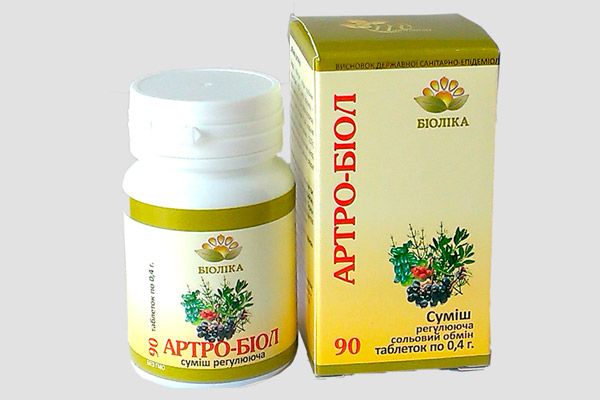
Rich in vitamins (C, P, B1, B2, E, K, B6), provitamin A, minerals – iron, copper, boron, manganese, molybdenum, fluorine, potassium, phosphorus, calcium, pectin and tannins.
Used in complex treatment of diseases: osteochondrosis, arthritis, arthrosis, gout, urolithiasis, cholelithiasis, water-electrolyte imbalance.
The preparation consists of chokeberry and rose hips, lingonberry leaves, knotweed and horsetail herbs, elecampane and burdock roots.
Silicon-biol
Silicon-biol has an astringent, hemostatic effect, promotes rapid healing of wounds. It is a strong diuretic, antispasmodic, has a bactericidal effect. Suppresses the inflammatory process, dilates blood vessels, normalizes heart rate. It has a positive effect on metabolic processes, promotes the absorption of vitamin and mineral complexes, and increases immunity.
Contains silicic acid and potassium salts, flavonoids, bitters, saponins, carotene, resins, tannins, vitamins B, C and provitamin A.
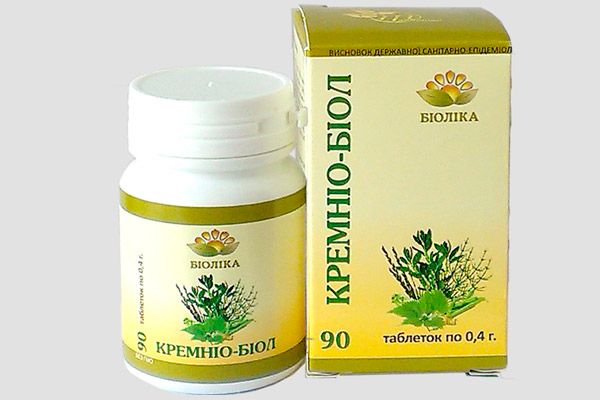
It is used in the complex treatment of osteochondrosis, arthrosis, atherosclerosis, urolithiasis, as well as metabolic disorders, intoxications, for the improvement of skin, teeth, hair, nails, bones.
The preparation consists of kaolin, horsetail, knotweed and couch grass, chicory root, bean pods, nettle leaves, and silicon oxide.
Calcio-biol
Calcio-biol has antipyretic, choleretic and sedative properties. It has anticarcinogenic and antisclerotic effects on the body. It dilates blood vessels, renews blood composition, strengthens the immune system and protects the body from free radicals.
Calcio-biol contains calcium citrate – a source of organic calcium, vitamins (C, A, B2, E, PP), taraxanthin, flavoxanthin, choline, saponins, resins, vegetable protein, salts of iron, manganese, calcium, phosphorus.
It is used in the complex treatment of dysfunctions of the musculoskeletal system, including rickets; osteochondrosis, coxarthrosis, bone fractures, periodontal disease, atherosclerosis, allergies, convulsive syndrome, as well as for the health of hair, teeth, bones.
The preparation consists of dandelion extract, ascorbic acid, vitamin D, calcium citrate, sodium polyphosphate, selenium and magnesium oxides.
Use as follows:
All listed biopreparations are taken orally. Adults should take two tablets three times a day half an hour before meals with a small amount of water. The health course should last from 8 to 12 weeks. A repeat course of taking the drug can be carried out after 2 or 3 weeks.
Contraindications for use:
- hypersensitivity to the components of the drug;
- age up to 14 years;
- pregnancy and lactation.
 [ 14 ], [ 15 ], [ 16 ], [ 17 ], [ 18 ], [ 19 ]
[ 14 ], [ 15 ], [ 16 ], [ 17 ], [ 18 ], [ 19 ]
Aescin
The active ingredient of this drug is escin. It is a mixture of triterpene saponins from horse chestnut seeds, slightly toxic and highly soluble in water.
Aescin's ability to relieve inflammation is to maintain the integrity of lysosome membranes, limiting the release of lysosomal enzymes that contribute to lethal cell damage and destroy proteoglycan. Reduces the permeability of the walls of arterioles, capillaries, and venules.
It is used in complex therapy for arthrosis as a highly effective angioprotector.
It is absorbed by tissues by approximately 11%. It is excreted in bile and urine.
Contraindicated in hypersensitivity, renal failure, in the first trimester of pregnancy and lactation. According to indications, taking Aescin in the second and third trimesters of pregnancy is not excluded.
Nausea, a feeling of heat, tachycardia, and skin rash may occasionally occur.
Aescin enhances the effect of anticoagulants; toxic effects are possible with antibiotics (aminoglycoside series, cephalosporins).
Tablets should be taken after meals with a glass of water - 40 mg / 3 times a day, maintenance dose - 20 mg / 2-3 times a day. Extended-release tablets are taken 2 times a day. The maximum dosage is 120 mg / day.
The shelf life is 3 years, provided the temperature regime is 15–25 °C.
Painkillers for Arthrosis
 [ 23 ], [ 24 ], [ 25 ], [ 26 ]
[ 23 ], [ 24 ], [ 25 ], [ 26 ]
Aspirin
The active ingredient is acetylsalicylic acid.
It has anti-inflammatory, antipyretic, analgesic activity, and prevents the formation of blood clots.
It is used in cases of pain and fever syndrome; in pathologies of connective tissue; to prevent the development of thrombosis, embolism, myocardial infarction.

To achieve an analgesic effect, tablets containing 0.5 g of acetylsalicylic acid are used.
The daily dose for adults is up to 3 g, divided into three doses. The duration of treatment is no more than two weeks.
Possible side effects: nausea, loss of appetite, pain in the upper abdomen, tinnitus, various allergic reactions, including asthma.
Long-term use may cause gastritis and duodenitis.
Contraindicated for use in case of gastroduodenal ulcer; thrombocytopenia; renal and hepatic dysfunction; bronchial asthma; under 15 years of age, pregnant women. Not used simultaneously with drugs that prevent thrombus formation.
During lactation, it is permissible to prescribe aspirin in moderate doses.
Not compatible with alcohol.
Store in a place protected from moisture for no more than 4 years.
 [ 27 ]
[ 27 ]
Ketoprofen
Non-steroidal anti-inflammatory drug. In case of joint diseases, it reduces their pain both when stationary and in motion, partially eliminates stiffness and swelling of joints after sleep, and promotes increased motor activity. It inhibits the activity of cyclooxygenase, as a result of which inflammatory and painful symptoms are eliminated.
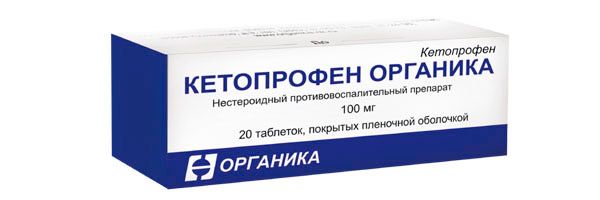
Ketoprofen provides pain relief by slowing down the synthesis of prostaglandins in the central and peripheral nervous system, as well as reducing the conductivity of the spinal tracts that provide the perception of pain signals and the formation of pain sensitivity. This drug is a powerful blocker of bradykinin, which lowers the pain threshold, a stabilizer of lysosomal membranes, preventing lysosomal enzymes from entering the synovial fluid. Prevents thrombus formation.
Oral administration ensures good absorption of ketoprofen from the gastrointestinal tract, with its greatest accumulation in the blood plasma observed after 1-2 hours.
Excretion is mainly in urine, less than 1% is excreted in feces.
Indications for use:
- collagenoses;
- inflammatory and degenerative joint pathologies;
- pain in the spine;
- post-traumatic pain;
- injuries without complications;
- inflammatory diseases of the veins and lymph nodes (in complex therapy).
Contraindications
- exacerbation of erosive and ulcerative diseases of the gastroduodenal zone;
- allergy to NSAIDs,
- dysfunction of the liver, kidneys;
- for women: the last three months of pregnancy and lactation;
- adolescence up to 15 years.
The dosage of the drug is selected by the attending physician, taking into account the severity of the disease. Adults take 0.3 g per day, divided into 2 or 3 doses.
The combined use of ketoprofen with other NSAIDs increases the likelihood of erosive and ulcerative complications of the gastrointestinal tract and hemorrhages; with antihypertensive drugs - a decrease in their effectiveness; with thrombolytics - the likelihood of hemorrhages.
Combined use with aspirin inhibits the binding of ketoprofen to plasma proteins, increasing the rate of blood purification from this drug; with heparin, ticlopidine - the likelihood of hemorrhages; with lithium preparations - lithium intoxication may occur due to its retention in the body's tissues.
Concomitant use with diuretics increases the risk of renal dysfunction.
Concomitant administration with probenecid slows down the elimination of ketoprofen from the body; with methotrexate, it increases the undesirable effects of this drug.
Concomitant use with warfarin causes severe hemorrhages, sometimes fatal.
For vital indications, ketoprofen can be used in the first 6 months of pregnancy, taking into account the possibility of potential complications for the fetus.
Side effects of ketoprofen:
- pain in the epigastric region;
- dyspeptic phenomena;
- dysfunctions of the digestive organs (rarely erosive and ulcerative pathologies of the gastroduodenal zone with hemorrhagic manifestations and perforation);
- allergy (rash, occasionally – bronchospasm);
- headache, dizziness, drowsiness.
Store for 5 years at temperatures up to 25°C. Keep out of reach of children.
Diclofenac
The active substance is diclofenac sodium. It belongs to non-salicylate non-steroidal anti-inflammatory drugs.
It is able to relieve inflammation, fever and pain syndrome by inhibiting the biosynthesis of prostaglandins, which cause pain and swelling at the epicenter of inflammation.

In collagenoses, it reduces inflammation, pain, stiffness and swelling of the joint, especially in the morning, improving its functioning.
In case of traumatic injuries and after surgeries, diclofenac helps to reduce pain and eliminate swelling.
It is absorbed by the body tissues quickly, the highest concentration after oral administration is observed after 2-3 hours and is proportional to the dose taken. The presence of food in the stomach slows down absorption by 1-4 hours and accumulation by 40%.
50% of the drug taken is absorbed, which almost completely penetrates into the blood plasma, combining with albumins, and into the synovial fluid, where the highest concentration is formed later and accumulates longer than in the plasma.
Metabolic products are excreted 65% in urine, up to 1% in feces, and the remainder in bile.
Diclofenac is used for:
- pathologies of the musculoskeletal system of various etiologies;
- collagenoses;
- inflammatory and degenerative pathologies of joints;
- moderate pain of various etiologies;
- fever.
Diclofenac is contraindicated in:
- exacerbations of erosions and ulcers of the gastroduodenal zone (including those with hemorrhages);
- allergies to NSAIDs,
- disruption of the hematopoiesis process;
- disruption of the blood clotting process;
Not prescribed to pregnant women and nursing mothers, as well as preschool children (up to and including 6 years of age).
Caution should be exercised when prescribing diclofenac to patients over 65 years of age, individuals with a history of anemia, bronchial asthma, ischemic heart disease, high blood pressure, edema, liver and kidney dysfunction, alcoholism, gastroduodenitis, erosions and ulcers of the gastroduodenal zone in remission, as well as diabetics and postoperative patients.
Use without crushing, with or after meals, with a glass of water. Dosage for adults and adolescents over 14 years old - from 25 to 50 mg two or three times a day. The highest permissible dose is 150 mg per day.
When satisfactory health is achieved, the dosage of the drug is gradually reduced to 50 mg per day.
For children over 6 years of age, the recommended dose is up to 2 mg of the drug per 1 kg of the child’s body weight, divided into 2 or 3 doses.
Overdose of diclofenac can cause vomiting, dizziness, headache, shortness of breath, clouded consciousness; in childhood – high convulsive readiness, nausea, abdominal pain, hemorrhages, liver and kidney dysfunction.
Emergency care in case of overdose consists of gastric lavage and administration of adsorbents.
Concomitant use with digoxin, methotrexate, lithium preparations and cyclosporines increases their absorption by blood plasma, increasing toxicity; with diuretics - reduces their effectiveness, with potassium-sparing diuretics - the possibility of hyperkalemia.
Reduces the effect of hypoglycemic, hypotensive and hypnotic drugs.
Concomitant use with cephalosporins, valproic acid can cause prothrombin deficiency, with cyclosporins and drugs containing gold, can cause kidney intoxication.
Concomitant use with aspirin reduces the absorption of diclofenac, with paracetamol it stimulates the possible manifestation of the toxic effect of diclofenac on the kidneys.
The risk of hemorrhages (usually gastroduodenal) increases when used in combination with:
- other NSAIDs;
- anticoagulants;
- glucocorticosteroids;
- thrombolytics;
- alcohol;
- colchicine;
- adrenocorticotropic hormone;
- preparations containing St. John's wort.
Diclofenac activates the properties of drugs that stimulate photosensitivity
Concomitant use with tubular secretion blockers increases the toxicity of diclofenac.
Using this medicine may cause the side effects listed below.
Most often they occur in the digestive organs: abdominal pain, gas accumulation in the intestines, bowel disorders, nausea, flatulence, increased AST and ALT levels in the blood, peptic ulcer disease complicated by hemorrhagic manifestations or perforation, gastroduodenal bleeding, yellowing of the skin, tarry stools, etc.
Less common are disorders of the nervous system and sensory organs; skin rashes, partial or complete hair loss, abnormal reactions to sunlight, and pinpoint hematomas may appear.
Acute renal failure, nephrotic syndrome, the appearance of protein and/or blood in the urine, inhibition of urine formation, interstitial nephritis, necrotic papillitis may be observed.
Sometimes the use of diclofenac causes the hematopoietic organs to react with a decrease in the level of hemoglobin, leukocytes, platelets, granulocytes, an increase in the number of eosinophils, or the immune system to an exacerbation of infectious processes.
Side effects may include cough, bronchospasm, laryngeal edema, atypical inflammatory processes in the lungs, hypertension, myocardial weakness, extrasystole, and chest pain.
As manifestations of hypersensitivity to diclofenac, anaphylactic and anaphylactoid reactions are observed.
Patients taking diclofenac should not engage in activities that require concentration and quick reactions. Incompatible with alcohol.
Store for no more than three years, maintaining a temperature of up to 25°C, in a dark, dry place. Keep out of reach of children.
 [ 28 ], [ 29 ], [ 30 ], [ 31 ]
[ 28 ], [ 29 ], [ 30 ], [ 31 ]
Indomethacin
It is an active non-steroidal anti-inflammatory drug. It has the ability to relieve inflammation, fever and pain by inhibiting the biosynthesis of prostaglandins that cause pain and swelling at the epicenter of inflammation.
Pharmacological properties, indications and contraindications for use are generally similar to diclofenac tablets.
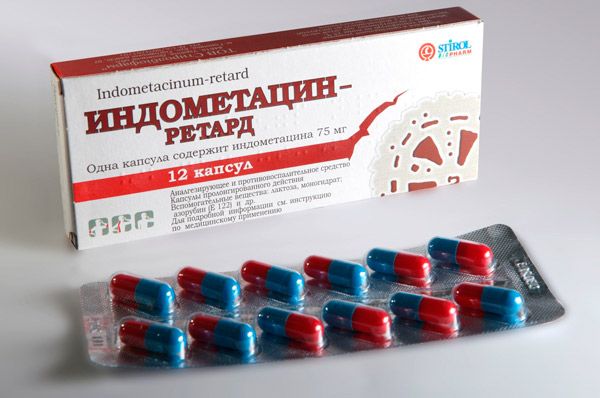
Indomethacin tablets are not prescribed to women during pregnancy and breastfeeding, as well as to children under 14 years of age inclusive.
Side effects:
- dyspeptic disorders;
- pain in the abdominal area;
- erosions, ulcers, hemorrhages and perforations of the gastroduodenal zone;
- catarrhal, allergic stomatitis;
- inflammatory-dystrophic changes in the gastric mucosa;
- toxic-allergic liver damage;
- headache,
- dizziness, depression, drowsiness;
- mental disorders;
- disturbance of heart rhythm and heart rate;
- arterial hypertension or hypotension;
- allergy;
- leukopenia;
- thrombohemorrhagic syndrome, decreased blood clotting;
- anemia;
- hearing and vision dysfunctions;
- renal dysfunction;
- occasionally – intestinal obstruction.
Use without crushing, during or after meals. It is better to drink with milk. Start with 25 mg two or three times a day. If there is no satisfactory therapeutic effect, the dosage is increased to 50 mg three or four times a day. The maximum permissible daily dose is 200 mg. The duration of treatment is at least 4 weeks.
For long-term use, the maximum permissible daily dose is 75 mg.
Overdose may manifest itself as dyspepsia, severe headache, forgetfulness, dysfunction of the vestibular apparatus, numbness of the extremities, and convulsions.
Concomitant use of indomethacin with other drugs:
- reduces the effectiveness of diuretics, beta-blockers;
- increases the effectiveness of indirect anticoagulants;
- with diflunisal, hemorrhagic syndrome in the gastroduodenal zone is possible;
- with probenecid, the accumulation of indomethacin in the blood plasma increases;
- with methotrexate and cyclosporine the toxicity of these drugs increases;
- with digoxin, an increase in the accumulation of digoxin in the blood plasma and an increase in its half-life are possible;
- At a dosage of 150 mg indomethacin, the accumulation of lithium in the blood plasma increases and its excretion is inhibited.
Store for 3 years at a temperature of up to 25 °C, in a dark place. Keep out of reach of children.
Modern chondroprotectors containing glucosamine and chondroitin promote restoration of cartilage tissue and synovial fluid. Acting in combination with them, anti-inflammatory and pain-relieving drugs stop the process of joint destruction. With timely treatment, pills for arthrosis can maintain the working condition of joints for a long time.
Attention!
To simplify the perception of information, this instruction for use of the drug "Osteoarthritis pills" translated and presented in a special form on the basis of the official instructions for medical use of the drug. Before use read the annotation that came directly to medicines.
Description provided for informational purposes and is not a guide to self-healing. The need for this drug, the purpose of the treatment regimen, methods and dose of the drug is determined solely by the attending physician. Self-medication is dangerous for your health.

